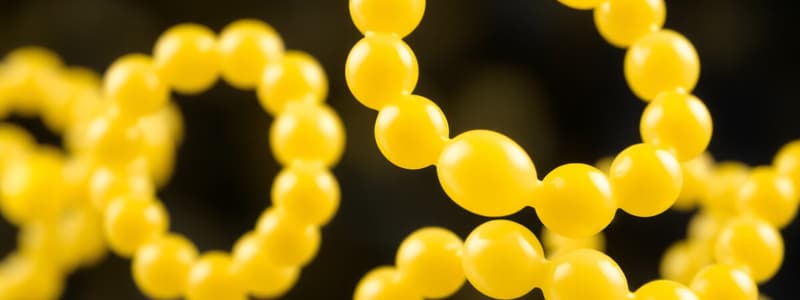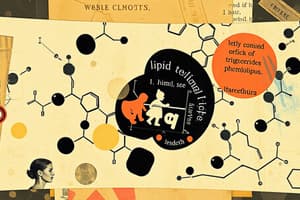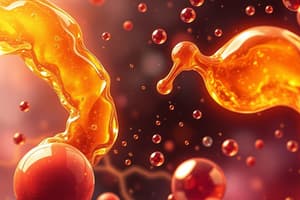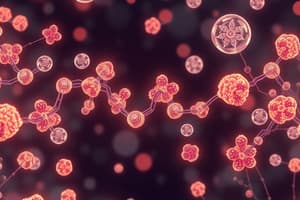Podcast
Questions and Answers
Which type of lipid is primarily used for long-term energy storage in the body?
Which type of lipid is primarily used for long-term energy storage in the body?
- Waxes
- Steroids
- Phospholipids
- Triglycerides (correct)
Unsaturated fats contain no double bonds in their fatty acid chains.
Unsaturated fats contain no double bonds in their fatty acid chains.
False (B)
What is the structure of a triglyceride?
What is the structure of a triglyceride?
Three fatty acids and one glycerol molecule
Lipids have _ carbon, hydrogen, and oxygen_ as components, but in lower amounts of _ compared to carbohydrates_.
Lipids have _ carbon, hydrogen, and oxygen_ as components, but in lower amounts of _ compared to carbohydrates_.
Match the following terms with their descriptions:
Match the following terms with their descriptions:
What are triglycerides primarily composed of?
What are triglycerides primarily composed of?
Triglycerides provide 7 kcal/gm of energy.
Triglycerides provide 7 kcal/gm of energy.
Name one function of triglycerides in the body.
Name one function of triglycerides in the body.
Phospholipids contain __________ fatty acids and phosphoric acid.
Phospholipids contain __________ fatty acids and phosphoric acid.
Match the following health effects with their related lipid types:
Match the following health effects with their related lipid types:
Which of the following is a benefit of omega-3 fats?
Which of the following is a benefit of omega-3 fats?
Phospholipids are considered dietary essentials.
Phospholipids are considered dietary essentials.
What is the role of phospholipids in the cell membranes?
What is the role of phospholipids in the cell membranes?
What is the basic structure of an amino acid composed of?
What is the basic structure of an amino acid composed of?
All amino acids have a chiral carbon atom.
All amino acids have a chiral carbon atom.
What is formed when two amino acids combine?
What is formed when two amino acids combine?
Amino acids can behave as both an acid and a base, making them __________.
Amino acids can behave as both an acid and a base, making them __________.
Match the following amino acids with their properties:
Match the following amino acids with their properties:
What molecule do amino acids form in neutral aqueous solutions?
What molecule do amino acids form in neutral aqueous solutions?
The amino acids found in proteins are primarily in the D form.
The amino acids found in proteins are primarily in the D form.
How many different amino acids make up human proteins?
How many different amino acids make up human proteins?
When a peptide bond is formed, a __________ molecule is lost.
When a peptide bond is formed, a __________ molecule is lost.
What is one function of proteins?
What is one function of proteins?
Which of the following amino acids is not classified as essential?
Which of the following amino acids is not classified as essential?
The primary structure of a protein is determined solely by the folding of the amino acid chain.
The primary structure of a protein is determined solely by the folding of the amino acid chain.
List two examples of essential amino acids.
List two examples of essential amino acids.
The ______________ structure of a protein stabilizes its three-dimensional shape.
The ______________ structure of a protein stabilizes its three-dimensional shape.
Match the following levels of protein structure with their definitions:
Match the following levels of protein structure with their definitions:
Which of the following bonds contributes to the stabilization of the secondary structure of proteins?
Which of the following bonds contributes to the stabilization of the secondary structure of proteins?
All amino acids are essential for human health and must be obtained from the diet.
All amino acids are essential for human health and must be obtained from the diet.
What type of reaction allows amino acids to form proteins?
What type of reaction allows amino acids to form proteins?
Four ways that parts of the amino acid side chains interact to stabilize tertiary structure include ______________, hydrogen bonding, ionic interactions, and Van der Waals forces.
Four ways that parts of the amino acid side chains interact to stabilize tertiary structure include ______________, hydrogen bonding, ionic interactions, and Van der Waals forces.
Which amino acid is included in the list of essential amino acids?
Which amino acid is included in the list of essential amino acids?
Which of the following types of bonds is formed between the –NH2 and –COOH groups?
Which of the following types of bonds is formed between the –NH2 and –COOH groups?
Covalent bonds, such as disulfide bridges, are strong interactions in proteins.
Covalent bonds, such as disulfide bridges, are strong interactions in proteins.
What is the quaternary structure of a protein?
What is the quaternary structure of a protein?
Denaturation of proteins usually results in a loss of __________ activity.
Denaturation of proteins usually results in a loss of __________ activity.
Match the following types of protein interactions with their descriptions:
Match the following types of protein interactions with their descriptions:
Which type of reaction usually causes irreversible protein denaturation?
Which type of reaction usually causes irreversible protein denaturation?
Some proteins can return to their native structures after denaturation if conditions are restored correctly.
Some proteins can return to their native structures after denaturation if conditions are restored correctly.
What is the primary reagent used in the Biuret test for proteins?
What is the primary reagent used in the Biuret test for proteins?
The __________ structure of proteins is determined by the arrangement of their subunits.
The __________ structure of proteins is determined by the arrangement of their subunits.
How many amino acids are there approximately in one turn of a helix?
How many amino acids are there approximately in one turn of a helix?
What term describes the specific sequence of amino acids in a protein?
What term describes the specific sequence of amino acids in a protein?
There are 20 essential amino acids needed by the human body.
There are 20 essential amino acids needed by the human body.
Name two common structures found in the secondary structure of proteins.
Name two common structures found in the secondary structure of proteins.
The amino acids that the human body cannot synthesize and must be taken from food sources are known as __________ amino acids.
The amino acids that the human body cannot synthesize and must be taken from food sources are known as __________ amino acids.
Match the following amino acids with their classification:
Match the following amino acids with their classification:
Which of the following statements best describes a zwitterion?
Which of the following statements best describes a zwitterion?
Which level of protein structure is characterized by the overall three-dimensional shape of a single polypeptide chain?
Which level of protein structure is characterized by the overall three-dimensional shape of a single polypeptide chain?
Hydrogen bonds play a crucial role in stabilizing the tertiary structure of proteins.
Hydrogen bonds play a crucial role in stabilizing the tertiary structure of proteins.
All amino acids are chiral.
All amino acids are chiral.
What are the two functional groups present in every amino acid?
What are the two functional groups present in every amino acid?
What type of chemical reaction allows amino acids to link together to form proteins?
What type of chemical reaction allows amino acids to link together to form proteins?
When two amino acids combine, a ________ is formed.
When two amino acids combine, a ________ is formed.
The __________ structure of proteins involves the interaction between multiple polypeptide chains.
The __________ structure of proteins involves the interaction between multiple polypeptide chains.
What primarily determines the primary structure of a protein?
What primarily determines the primary structure of a protein?
Amino acids can only function as acids and not as bases.
Amino acids can only function as acids and not as bases.
List one function of proteins in the body.
List one function of proteins in the body.
Proteins are polymers formed from a sequence of ________.
Proteins are polymers formed from a sequence of ________.
Which of the following correctly describes the secondary structure of a protein?
Which of the following correctly describes the secondary structure of a protein?
Which type of bond is formed between the –NH2 and –COOH groups in proteins?
Which type of bond is formed between the –NH2 and –COOH groups in proteins?
The quaternary structure of proteins refers to the linear sequence of amino acids.
The quaternary structure of proteins refers to the linear sequence of amino acids.
What happens to proteins upon denaturation?
What happens to proteins upon denaturation?
Disulfide bridges are formed by the oxidation of the ____ groups in cysteine molecules.
Disulfide bridges are formed by the oxidation of the ____ groups in cysteine molecules.
Which of the following is a factor that can lead to protein denaturation?
Which of the following is a factor that can lead to protein denaturation?
Denaturation of proteins is always irreversible.
Denaturation of proteins is always irreversible.
Biuret reagent turns ____ when mixed with a solution containing protein.
Biuret reagent turns ____ when mixed with a solution containing protein.
Which type of bond is NOT considered a weak interaction in proteins?
Which type of bond is NOT considered a weak interaction in proteins?
Flashcards
Triglycerides
Triglycerides
The predominant form of fat in food and the major storage form of fat in the body, composed of three fatty acids and glycerol.
Fatty Acids
Fatty Acids
Carboxylic acids with hydrocarbon chains, either saturated (no double bonds) or unsaturated (with double bonds).
Saturated Fats
Saturated Fats
Fats with all carbon atoms bonded to hydrogen atoms. They are solid at room temperature.
Unsaturated Fats
Unsaturated Fats
Signup and view all the flashcards
Lipids
Lipids
Signup and view all the flashcards
Triglyceride Structure
Triglyceride Structure
Signup and view all the flashcards
Triglyceride Function (Energy)
Triglyceride Function (Energy)
Signup and view all the flashcards
Triglyceride Health Risk
Triglyceride Health Risk
Signup and view all the flashcards
Phospholipid Structure
Phospholipid Structure
Signup and view all the flashcards
Phospholipid Function
Phospholipid Function
Signup and view all the flashcards
Saturated vs Unsaturated Fats
Saturated vs Unsaturated Fats
Signup and view all the flashcards
Ester Linkage
Ester Linkage
Signup and view all the flashcards
Health Benefits of Unsaturated Fats
Health Benefits of Unsaturated Fats
Signup and view all the flashcards
Amino Acid Structure
Amino Acid Structure
Signup and view all the flashcards
Peptide Bond
Peptide Bond
Signup and view all the flashcards
What are proteins?
What are proteins?
Signup and view all the flashcards
Primary Protein Structure
Primary Protein Structure
Signup and view all the flashcards
Secondary Protein Structure
Secondary Protein Structure
Signup and view all the flashcards
Tertiary Protein Structure
Tertiary Protein Structure
Signup and view all the flashcards
Quaternary Protein Structure
Quaternary Protein Structure
Signup and view all the flashcards
Hemoglobin
Hemoglobin
Signup and view all the flashcards
Collagen
Collagen
Signup and view all the flashcards
Zwitterion
Zwitterion
Signup and view all the flashcards
Essential Amino Acids
Essential Amino Acids
Signup and view all the flashcards
What are the four levels of protein structure?
What are the four levels of protein structure?
Signup and view all the flashcards
Primary Structure
Primary Structure
Signup and view all the flashcards
Secondary Structure
Secondary Structure
Signup and view all the flashcards
Tertiary Structure
Tertiary Structure
Signup and view all the flashcards
What are the four interactions that stabilize tertiary structure?
What are the four interactions that stabilize tertiary structure?
Signup and view all the flashcards
Quaternary Structure
Quaternary Structure
Signup and view all the flashcards
What does 'condensation reaction' mean in the context of protein formation?
What does 'condensation reaction' mean in the context of protein formation?
Signup and view all the flashcards
What is the role of hydrogen bonds in protein structure?
What is the role of hydrogen bonds in protein structure?
Signup and view all the flashcards
How does the primary structure determine the higher levels of protein structure?
How does the primary structure determine the higher levels of protein structure?
Signup and view all the flashcards
Covalent Bonding in Proteins
Covalent Bonding in Proteins
Signup and view all the flashcards
Hydrogen Bonding in Proteins
Hydrogen Bonding in Proteins
Signup and view all the flashcards
Ionic Bonding (Salt Bridges) in Proteins
Ionic Bonding (Salt Bridges) in Proteins
Signup and view all the flashcards
Hydrophobic Interactions in Proteins
Hydrophobic Interactions in Proteins
Signup and view all the flashcards
Protein Denaturation
Protein Denaturation
Signup and view all the flashcards
Irreversible Denaturation
Irreversible Denaturation
Signup and view all the flashcards
Biuret Test
Biuret Test
Signup and view all the flashcards
Biuret Test Mechanism
Biuret Test Mechanism
Signup and view all the flashcards
Peptide Bond Formation
Peptide Bond Formation
Signup and view all the flashcards
What is a Zwitterion?
What is a Zwitterion?
Signup and view all the flashcards
Hemoglobin - Globular Protein
Hemoglobin - Globular Protein
Signup and view all the flashcards
Collagen - Fibrous Protein
Collagen - Fibrous Protein
Signup and view all the flashcards
What stabilizes tertiary structure?
What stabilizes tertiary structure?
Signup and view all the flashcards
How does the primary structure influence higher levels of protein structure?
How does the primary structure influence higher levels of protein structure?
Signup and view all the flashcards
What is condensation reaction in protein formation?
What is condensation reaction in protein formation?
Signup and view all the flashcards
What is the role of hydrogen bonds in secondary structure?
What is the role of hydrogen bonds in secondary structure?
Signup and view all the flashcards
What makes proteins different from each other?
What makes proteins different from each other?
Signup and view all the flashcards
Protein Structure Levels
Protein Structure Levels
Signup and view all the flashcards
What is a peptide bond?
What is a peptide bond?
Signup and view all the flashcards
Study Notes
Lipids
- Lipids are long-term energy storage, providing concentrated energy.
- Lipids are macromolecules made of fatty acid monomers.
- Lipids' functions include structural support for cells, energy storage, and cell signaling.
- Lipids are non-polar and do not interact with water.
- Main types of lipids include triglycerides, phospholipids, steroids, and waxes.
Objectives
- Differentiate between condensation and hydrolysis reactions.
- Describe the molecular structure of triglycerides.
- Explain the role of triglycerides as an energy source.
- Describe the molecular structure of phospholipids.
- Explain the role of phospholipids in membrane structure and function.
Condensation and Hydrolysis
- Condensation reaction: Removing water from two monomers to form a dimer.
- Hydrolysis reaction: Adding water to break polymers or dimers into monomers.
What are Lipids?
- Lipids are macromolecules composed of carbon, hydrogen, and oxygen.
- They have a lower oxygen content than carbohydrates, reducing reactivity (often with fewer than six oxygen atoms).
- Lipids do not form polymers—rather, they are large molecules made of smaller subunits.
- They are not continuing chains, but a collection of monomers.
Types of Lipids
- Triglycerides
- Phospholipids
- Steroids
- Waxes
Triglycerides
- Triglycerides are the predominant form of fat in foods.
- They are the major storage form of fat in the body.
- Triglycerides consist of three fatty acids joined to glycerol.
Fatty Acids and Fats
- A fatty acid is a carboxylic acid with an aliphatic chain, either saturated or unsaturated.
- Saturated fatty acids have no double bonds.
- Unsaturated fatty acids have one or more double bonds.
- Double bonds cause kinks in the chain, preventing tight packing and resulting in generally liquid form.
Saturated vs. Unsaturated Fat
- Saturated fatty acids have no double bonds, are straight, and tend to be solid at room temperature.
- Unsaturated fatty acids have one or more double bonds, tend to be liquid at room temperature, and have kinks in the chain.
- Saturated fats are associated with cardiovascular disease.
Fatty Acids
- Fatty acid carbon chains differ in length and saturation, affecting absorption and affecting chemical structure.
- Length affects absorption.
- Saturation affects cooking and storage properties, as well as health.
Saturated Fats
- Saturated fats have all carbon atoms bonded to hydrogen atoms.
- They are solid at room temperature, and are mostly found in animal products.
- Saturated fats contribute to cardiovascular disease.
Unsaturated Fats
- Unsaturated fats have carbon-carbon double bonds.
- They are liquid at room temperature and mostly found in plant and fish products..
- Contain "kinks" due to the double bonds which prevents tight packing.
Building Fats
- Triglycerides (or triacylglycerols) are formed by linking three fatty acids to glycerol.
- Ester linkages connect the fatty acids to the glycerol.
Triglycerides are Esters of Glycerol and Fatty Acids
- Glycerol is a water-soluble backbone alcohol.
- Fatty acids are chains of carbon atoms with hydrophobic ends.
- Condensation reaction forms triglycerides and releases water.
Hydrogenation of Unsaturated Fats
- Hydrogenation adds hydrogen across double bonds in unsaturated fats, converting them to saturated fats.
- This process solidifies liquid oils, making them more shelf-stable.
- Hydrogenation is common in food production (e.g., margarine, shortening).
Digestion, Functions, and Health Effects of Triglycerides
- Function in the body: energy (9 kcal/gm), insulation & protection, metabolic water (from hydrolysis), contribute to flavor/aroma, and carry fat-soluble vitamins (A, D, E, K).
Health Effects of Lipids
- Excess fat intake contributes to obesity, diabetes and cancer.
- Saturated fats raise blood cholesterol, which can lead to heart disease.
- Trans fats can increase LDL and decrease HDL levels.
- Beneficial unsaturated fats (e.g., monounsaturated and polyunsaturated) are associated with reduced blood cholesterol.
- Omega-3 and omega-6 fats associated with reduced blood cholesterol and cancer prevention.
Phospholipids
- Similar to triglycerides in structure. Include two fatty acid chains and a phosphate group connected to glycerol.
- The phosphate group is hydrophilic (attracted to water).
- The fatty acid chains are hydrophobic (repelled by water).
- Phospholipids form bilayers in water.
- Phospholipids are vital components of cell membranes.
- Functions include cell membrane structure & emulsifier, essential for fat transport.
Role in Membrane Bilayer
- Phospholipid heads are water-soluble (hydrophilic).
- Phospholipid tails are water-insoluble (hydrophobic).
- Phospholipids form bilayers in water to insulate the hydrophobic tails from water, creating a membrane.
Triglycerides vs. Phospholipids
- Triglycerides store energy, and phospholipids are structural components of cell membranes.
- Triglycerides consist of three fatty acid chains linked with a glycerol backbone.
- Phospholipids consist of two fatty acid chains and a phosphate group on a glycerol backbone.
Studying That Suits You
Use AI to generate personalized quizzes and flashcards to suit your learning preferences.




